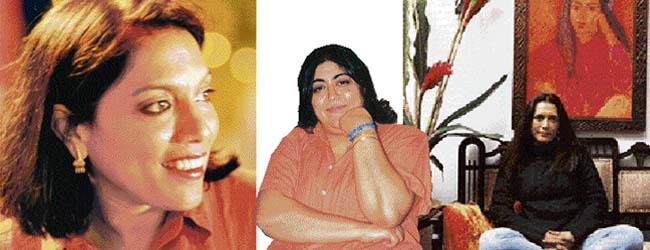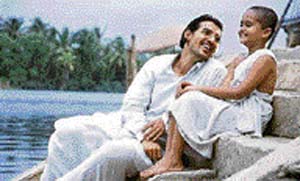|
Mistresses of
Crossover
Cinema

These three
Punjabi women have done cinema proud. They have taken Bollywood
to the world and brought the West to Bollywood. Their films,
exploring human mindscape and relationships in a variety of
socio-cultural settings, are a hit with both western and Indian
audiences.
Randeep Wadehra
reels off the acclaimed contribution of film-makers Mira Nair,
Gurinder Chadha and Deepa Mehta to cross-cultural cinema
THESE
three women have managed to straddle the cultural twain:
Amritsar-born Deepa Mehta, Bhubaneshwar-born Mira Nair and
Nairobi-born Gurinder Chadha are highly talented film directors,
producers, writers and actors. What sets these three apart from
their peers is the fact that they are Punjabi women who have
successfully spanned the East-West civilisational fault – as
far as cinematic sensibility and creativity are concerned. Their
works are watched, understood and critically acclaimed as much
in India as in the West.
One can have some
idea of their calibre if one takes a look at the awards they
have won. Mira Nair’s works, apart from nominations to BAFTA
and Oscars, have won Golden Camera (1998), Silver Ribbon (1992),
New Generation and Lilian Gish Awards (1998), as well as Golden
Lion (2001). Deepa Mehta bagged the 2006 Genie Award for
outstanding achievement in cinematography, Golden Kinnaree Award
at Bangkok International Film Festival (2006), The Silver Mirror
(2006) etc, along with the recent nomination to the Academy
Awards for Water. In addition to being nominated for
Writers Guild of America’s best original screenplay award in
2003 (Bend it like Beckham), Gurinder Chadha’s
contribution to cinema was recognised with the OBE decoration by
the British government in June 2006.
|


FILMS WITH A MESSAGE: Stills from Deepa Mehta’s Water (top) and Gurinder Chadha’s Bend it like Beckham (above)
|
The trio is
equally comfortable while making movies, telefilms and
documentaries for Indian as well as western audiences. Nair has
made flicks like Salaam Bombay, Mississippi Masala, The Perez
Family, My Own Country, Hysterical Blindness, Kama Sutra,
Monsoon Wedding, Vanity Fair and The Namesake to name
a few. Mehta’s better known movies include At 99: A
Portrait of Louise Tandy Murch, Sam & Me, Camilla, The
Republic of Love, Bollywood Hollywood, Earth, Fire and Water.
Some of the better known productions from Gurinder Chadha’s
oeuvre comprise The Mistress of Spices, Bride and Prejudice,
Bend it like Beckham, What’s Cooking?, A Nice Arrangement,
What Do You Call An Indian Woman Who’s Funny?, Bhaji on
the Beach and Acting Our Age.
The three
film-makers have explored human mindscapes and
relationships in a variety of socio-cultural environments, which
are generally alien or oppressive or both. You get a rather
detailed look into the world of the marginalised or the outsider
in movies like Salaam Bombay (street children), Earth
(Lenny, the Parsi girl) and Water (the exploited widows).
You get a glimpse of inter-racial relationships in movies like The
Mistress of Spices, The Namesake and Mississippi Masala.
Quite a few of the movies are about adaptation and adjustent to
alien cultures or individuals from different backgrounds.
In Bend it like
Beckham, Jasminder Bhamra feels more British than Indian and
wants to play football like her peers such as Juliette. But her
mother forbids her. In the ensuing struggle between the
subcontinental orthodox mindset and western liberal values, the
latter win as her parents give in to her wishes. Simiarly, in The
Namesake you find Ashok and Ashima – married according to
Bengali traditions – trying to adjust to their children’s
lifestyle, especially son Gogol’s American way of living. In
turn Gogol too has to come to terms with the relative frailty of
love relationships in the western milieu — be it his affair
with the American Maxine or marriage with the Indian Moushumi.
But, the movies
are not just about families caught in the vortex of cultural
differences. There are individuals outside families too who
adapt to ‘the other’ in order to minimise the effect of
cultural clash. For example Sam & Me focuses on the
equation between a Muslim boy and an elderly Jew living in
Canada.
Another striking
feature of the trio’s works is predominance of female
protagonists and their strong characterisations. Whether it is
the neglected Sita and the abandoned Radha coming together in
quest of love (Fire), the domineering Madhumati, the
innocent imp Chuiya, the yearning-for-freedom Kalyani (Water)
or Tilo, who is torn between her love for Doug and the call of
the spices, all these characters leave more than a lingering
impression on one’s mind. Moreover, humour, mischief and joy
do make an appearance in most of their movies.
However, there are
differences in the manner in which the three film-makers treat
their subjects. Chadha uses lots of colour that exudes energy.
If you remember the rather vigorous dance sequence in the bazaar
in Bride and Prejudice you will recall the frisson it
triggered off in your entire being. Even in The Mistress of
Spices or Bend it like Beckham you hardly find any
gloomy ambience although colours are relatively muted in the
former.
You can say the
same about Nair. She, too, prefers bright ambience for her
movies. This is not to say that the two are unmindful of the
narrative’s tenor or that they lend artificial hues to the
general mood and texture. The end product of their efforts is
eminently authentic. Mehta, in contrast, has not hesitated while
employing sombre colour and complexion — you notice this
especially in the ‘elements trilogy’ Earth, Fire and Water.
Then there is the matter of cinematic metaphor — rains, for
example.
Ever since its
inception, the Indian cinema has been using rains to portray
sensuality, joy, celebration and rejuvenation. However, in Monsoon
Wedding Nair uses this device to depict something more than
joy and celebration. Rain also becomes the symbol of the coming
together of different classes, as the well-off mingle with their
minions in a communal rain-drenched dance. More importantly, it
is a happy aftermath to Shefali Shah’s angst-ridden outburst
against her paedophile ‘Tej Uncle’.
In Water,
on the other hand, rains bring in transitory, nay illusionary,
joy in the lives of Kalyani and Chuiya. When the two dance in
the room as it drizzles outside, you are filled with sympathy
for them, for you instinctively know that their fate has already
been sealed by society. Here, the rainfall is more a symbol of
hope-amidst-hopelessness than an expression of sensuality.
Mehta also employs
light and shade to effectively communicate with the viewers. For
example, in the climactic scene in Water Shakuntala
places Chuiya into Narayan’s hands as the train moves from the
rather dark platform towards the sunlit world beyond. You
realise that at least the widowed child has escaped further
molestation at the hands of upper-caste landlords for whom
widows are nothing more than sex objects.
Come to think of
it, things haven’t changed much since 1938 if one takes a look
at the plight of abandoned widows in Varanasi and Vrindavan —
the legend at the end of the movie is a stark reminder of this
enduring blot on our society. Contrast this with the movie’s
beginning — Chuiya travelling with her husband and in-laws
amidst verdant greenery. The grey colours suddenly obliterate
all brightness when she becomes a widow. Dark shadows play on
her expressionless face as her locks are shorn off.
While watching
their movies, you tend to forget the language in which these are
made – Hindi, English or Hinglish, and ignore the nationality,
ethnicity or cultural identity of the characters. The imagery is
so powerful and lucid that you tend to get involved with the
flow of the narrative. Truly, Mehta, Nair and Chadha are the MNC
of transcultural cinema.
|